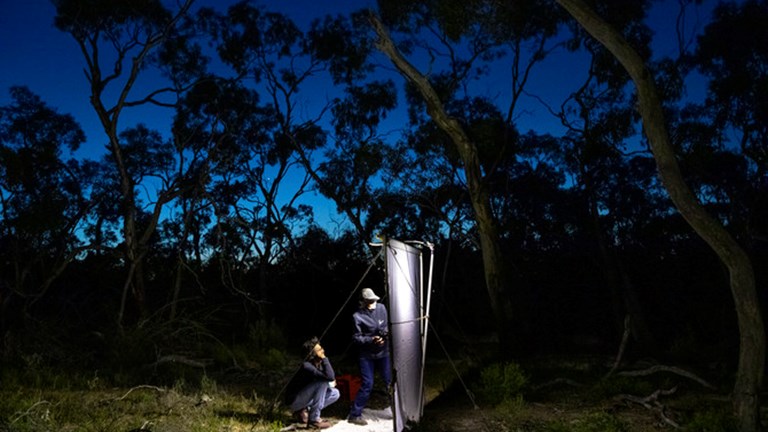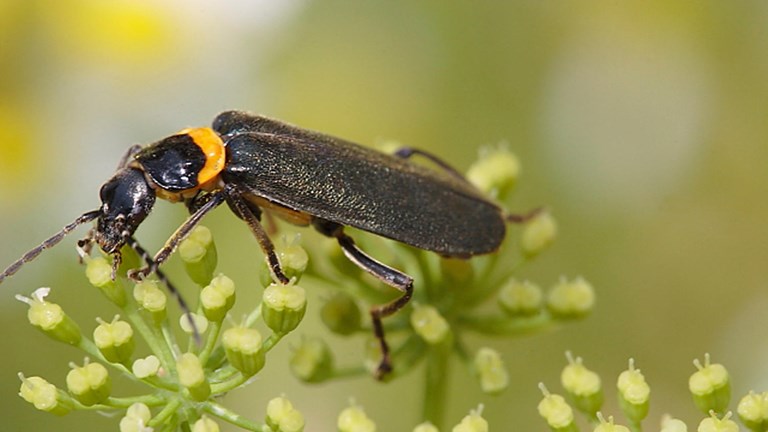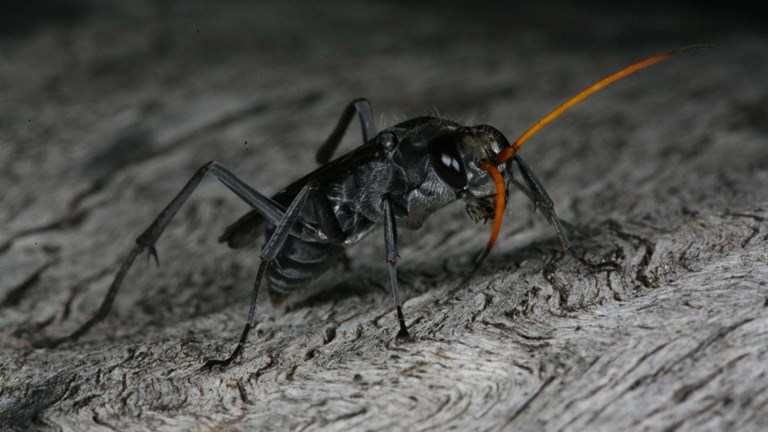













Bee evolution
‘A bee is simply a vegan wasp, that’s all it is,’ explains Ken.
Bees evolved from ancient wasps, shortly (relatively speaking) after flowers first appeared around 150 million years ago.
‘Nature abhors a vacuum,’ says Ken, ‘And suddenly there was another source of protein in the form of pollen, as compared to having to get animal tissue.’
Wasps are carnivores, and one of these early groups already had a taste for pollen from preying on other insects that ate it.
‘They switched from being predatory, cut out the middle man, and went straight to the pollen,’ says Ken.
Bees also had to make some other physical changes, including the development of branched hairs to hold onto the pollen.
‘That’s the major morphological difference between wasps and bees—bees have branched hairs; wasps have simple hairs,’ says Ken.
Then, when Australia separated from Gondwana about 100 million years ago, the bees were left isolated from the rest of the world.
‘Native bees began developing around about 60 million years ago,’ says Ken.
‘They co-evolved with the Myrtaceous plant family—gum trees and tea trees.’
The flowers of these plants offer nectar in a broad, shallow cup, which has led to Australia’s native bees developing different characteristics.
‘Australia is quite unique in its bee population,’ says Ken.
‘We have a predominance of short-tongued bees; every other continent in the world has the opposite.’
Honey bees in Australia
When European colonists brought in fruit trees and other food plants, which require longer tongues to access the nectar, they found Australian native bees ignored them.
‘The short-tongued bees just couldn’t access the nectar, so they weren’t interested in the flowers, which is why they had to bring the honey bee in to do the pollination,’ says Ken.
‘In 1822 they brought in the first honey bees, on the ship the Isabella.
‘Firstly, to pollinate their crops, secondly, to give them a bit of honey in their tea and, thirdly, they wanted to use the wax to make candles.’
Over the last 200 years the European Honey Bee has become an indispensable part of Australian agriculture.
‘It has been very successful, but part of the success is that we treat honey bees like livestock,’ explains Ken.
‘We have purposely built up large numbers to pollinate various crops, and then when the crop needs pollination they will transport hundreds of hives.
‘A classic example is the almond crop along the Murray River—they’ve got about three weeks to get 100 per cent pollination of the crop, otherwise it’s worthless.
‘It’s worth over 500 million dollars to Australian export, and they bring in about seven billion honey bees.
‘Sometimes people say, “Why don’t we just let the native bees take over what the honey bees are doing?”
‘But you just simply can’t amass seven billion native bees,’ explains Ken.
Which highlights some important differences between these introduced animals and Australia’s natives.
‘Most Australian bees don’t make honey, there are only 11 that do out of the 2000 species,’ says Ken.
‘And almost all native bees don’t make hives, don’t make wax.’
So, where do they live?
‘Most of the native bees in Australia are solitary, so instead of being in a hive with a single queen and all the workers being sterile females, they have either above or below ground nests.
Only about one third of Australia’s native bees, including leaf-cutter bees and resin bees, nest above ground.
‘People will often see semicircular holes in the leaves of their garden, in their roses in particular,’ says Ken.
‘It’s the leaf-cutter bee that is cutting the leaves.
‘It cuts the semicircular leaf out, then it bends it into a “U” shape, and takes it back to the nest.’
And this solitary behaviour is vastly different to that of European honey bees.
‘The female [of a native species] gets a little pollen ball—we call it a pollen pudding—puts it into a brood cell, seals it up and goes away, so mother never meets daughter,’ explains Ken.
‘Whereas in honey bees, mother does meet daughter because the queen bee is laying about 2000 eggs a day and they are hatching and emerging very quickly.’
Over the last 200 years the European Honey Bee has become an indispensable part of Australian agriculture.
‘It has been very successful, but part of the success is that we treat honey bees like livestock,’ explains Ken.
But its diet, behaviour, and social structure means there is not a lot of competition with native bees.
‘The greatest competition with honey bees occurs when feral hives take over the nesting hollows of Australian lizards and parrots,’ says Ken.
‘That’s the real downside of honey bees.’
A sting in the tail
While honey bees are known for having a barbed sting that embeds itself in its victim, this is another area where native bees differ.
‘The sting is simply a modified ovipositor, which is the egg-laying tube,’ explains Ken.
‘The honey bee is the only bee that’s got back turned barbs on its sting; every other bee (and wasp) has got a smooth barb so they can sting, retract, and sting again.
‘One of the reasons the honey bee disembowels itself is it wants to put as much venom into the animal they’re attacking as they possibly can.’
It’s a sacrificial tactic, says Ken, due to the social structure of honey bees.
‘Interestingly it’s only the workers, the queen bee sting is smooth, because she doesn’t want to kill herself—if she did then the whole colony would be gone.
‘So, it’s fascinating, even the sting morphology is again designed success for the queen and yet death for the workers.’
But even in Australian native bees that can sting repeatedly, without the risk of disembowelling themselves, that doesn’t mean they will.
‘There are 2000 species of bees in Australia and all but 11 have a sting,’ says Ken.
‘Because they use their mandibles to dig holes in the ground, they’ve got very good mandibles.
‘I’ve found that in my 45 years of working with bees they prefer to bite rather than sting.’
Australian native bees
Australia has several different family groups of native bees, but one of these is a true success story.
‘The dominant family in Australia are called the Colletids and they contain some of the smallest bees in the world,’ says Ken.
‘There’s a group called Euryglossina (Quasihesma) and they’re just under two millimetres in body length, extremely small.’
And one of these is even named after Ken—Euryglossina (Quasihesma) walkeri—a new species he found in Cape York.
‘One of the dominant characteristics of many Australian Colletids…is that these bees do not carry pollen on the outside of their body,’ says Ken.
‘You typically think of a bee as being hairy to carry pollen but in fact the majority of Australian native bees don’t carry pollen on the outside, so they look like wasps.’
But rather than being a more primitive bee researchers have discovered that this adaptation is more recent in their evolutionary history.
‘The bees that we have in Australia, the Colletids, they are probably the last of the bees to evolve,’ explains Ken.
‘They found they simply didn’t need to be able to carry pollen on the outside of the body.
‘They got rid of the hairs and carry the pollen in the first part of the stomach, called the crop.
‘They are one of the most advanced bees in the world.’
Not needing to grow hair means they need fewer resources to thrive, but it does change the ecosystem.
‘If you’re carrying all the pollen in your stomach, not on the outside, you’re not a good pollinator.
‘They’re just selfish,’ laughs Ken.
So, who is pollinating the plants?
Buzz pollination
Hairless bees, of the group Colletidae, are just one of five families of bees that are native to Australia.
There are two other groups of short-tongued bees—Stenotritidae and Halictidae—and two of long-tongued bees—Apidae and Megachilidae.
And most of the bees in these families do have branched hairs that they use to carry pollen either on their hind legs, or on the underside of their abdomen.
It is among the Apidae group that we find some of Australia’s largest, and fuzziest, native bees—including carpenter bees and Dawson’s Bee.
‘Amegilla dawsoni, which occurs around Carnarvon in Western Australia, it’s about 25 millimetres long,’ says Ken.
‘In about August, spectacularly, thousands of males emerge and go in these mating swarms to mate with a female.
‘And the noise is just phenomenal.’
Dawson’s Bee is one species that uses its longer tongue to get pollen from flowers that would be ordinarily out of reach for short-tongued bees.
‘The male part of a plant is called an anther and in most cases the pollen is on the outside and a bee can scrape the pollen off and transfer it to the hind leg,’ says Ken.
Storing the pollen on the outside of their bodies means that every time they land on a new flower, some of that pollen is transferred to the female part of a flower, allowing the plant to reproduce.
But some plants, including native Dianella species and introduced tomatoes and potatoes, require a more specialised tactic to access their pollen.
These plants have a hollow, or poricidal, anther with the pollen on the inside.
So, what is a bee to do?
‘This is where the Blue-banded Bee comes in very nicely,’ says Ken.
‘The Blue-banded Bee is called buzz pollinator.
‘It comes along and puts its body over the poricidal anther and changes its wing beat frequency to be quite high which causes the pollen grains inside the hollow tube to bounce around, fly out the end, and cover the bee.’
Which is a neat solution to a tricky problem.
But some Australian native bees are content to let others, like the Blue-banded Bee, do all the work for them.
Bee parasites
Meet the cuckoo bee.
‘They’re parasitic; they are pollen thieves,’ says Ken.
‘The female Blue-banded Bee goes out, gathers a whole lot of pollen, makes a pollen ball under the ground, and lays an egg.
‘The cuckoo bee will fly into the hole and kill the egg or the larvae, lay an egg on the Blue-banded Bee’s pollen ball and then fly off.
‘So another species is using the resources of the Blue-banded Bee to grow its own.’
And the tactic has also led to this bee’s own physical adaptations.
‘They don’t have hairy legs; they have extra structure on their body because if they meet the Blue-banded Bee as they’re escaping there is going to be a fight,’ says Ken.
‘And so they have more armour to protect themselves from being bitten and stung.
‘They’re like little tanks.
‘They’re wonderful things, they’ve got this metallic blue colour and they’re quite a spectacular bee.’
But the cuckoo bees’ reliance on another species for its survival does limit its prospects.
‘Usually cuckoo bees are extremely closely related to their host, so blue-banded bees and cuckoo bees are in the same family,’ says Ken.
‘But you’ve always got to have a lower number of a parasite to the host otherwise the parasite would overwhelm the host and would wipe itself out.
‘If you have Blue Banded Bees you are guaranteed to have cuckoo bees.
‘Parasites are extremely host specific.’
In the case of the European Honey Bee, its main parasitic threat comes from the varroa mite.
The mites feed off and weaken the honey bees, reproduce within their hive, and pass on viruses which deform the bees’ wings meaning they can’t forage.
‘All of a sudden there is a whole worker force of the honey bee that can’t work and the colony collapses,’ says Ken.
Which can be disastrous for crop production and food chains that are reliant on them.
‘When you’ve got a managed hive, the apiarist is able to put in miticides and sticky traps that will catch the mites to reduce the number of mites within a colony,’ says Ken.
‘When no one is looking after it the mite just runs free.
‘Every continent that has had them [varroa mites] has lost about 50 per cent of their managed hives and almost all of their feral hives.
‘In Australia we get about 16 billion dollars’ worth of pollination per year, from the agricultural output, and we will lose at least 50 per cent of that.
‘Fruit trees will not be pollinated, they may not be able to get seven billion bees together for the almond crop pollination, there may be a failure.
‘You’ll find that a lot of fruit and vegetables will go up in price because there are less of them.
‘So the knock-on consequences of the varroa mite and the reduction of hives can be quite catastrophic, since we use them as a highly commercial bee.’
Fortunately, the solitary nature of Australian native bees means they are not at risk from the varroa mite.
But there are other threats.
What can we do to help bees?
One of Ken’s roles as a scientist is to map out where these native bees occur.
‘Until you know where an animal occurs, you don’t know how to protect it,’ he says.
And, like many Australian native animals, the threat to bees comes largely from human activity.
Urbanisation, agriculture, and pesticides are all bad news for insect populations.
‘Insects are the mainstay of almost all ecosystems in the world,’ says Ken.
‘If you remove the insects then suddenly everything above it will collapse.’
Which is bad news for us.
And Ken singles out neonicotinoid pesticides, or neonics, as one of the biggest risks to bee populations.
Once sprayed on a plant, neonics are absorbed into every part of it—which is what makes it so effective.
‘Any insect that eats part of the plant gets affected by it,’ says Ken.
So, if a bee eats the pollen from one of these plants it also ingests a neurotoxin that permanently binds to and destroys its nerve cells.
These pesticides were banned by the European Union in 2018, but they are still readily available in Australia.
Widescale land clearing is also a problem for bees, in that they need corridors of flowering plants to sustain their movement.
And as for things you can do, Ken suggests planting native flora, and building bee hotels to provide safe spaces for native bees to nest.
‘Most bee hotels are where you drill holes in wood or bamboo shoots,’ says Ken.
Such a simple thing can make a big difference to these thousands bees, whose natural habitats are increasingly under threat.
And now you know a bit more about bees, hopefully you’ll keep an eye out for them in your own backyard.
Bees are among our most important pollinators and a crucial part of ensuring our food supply.
And the better we look after them, the better they will look after us.













